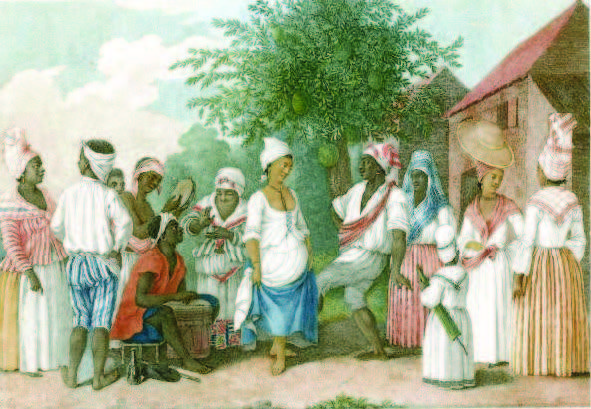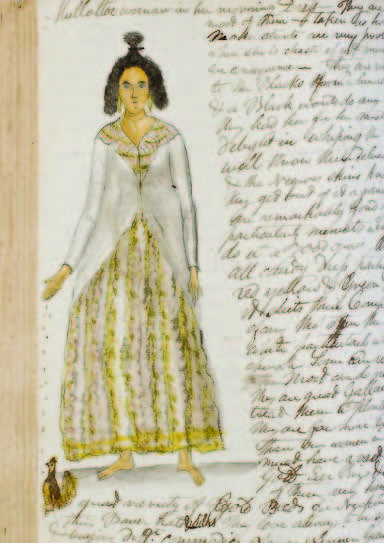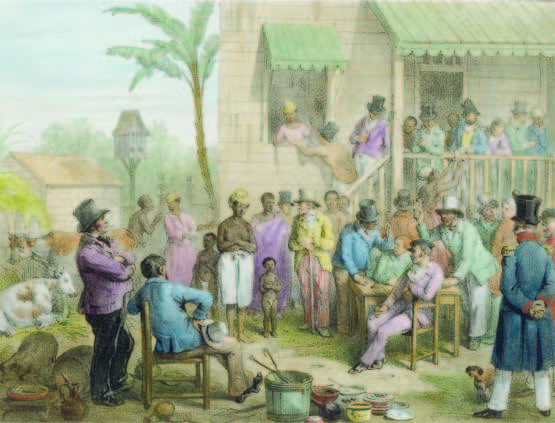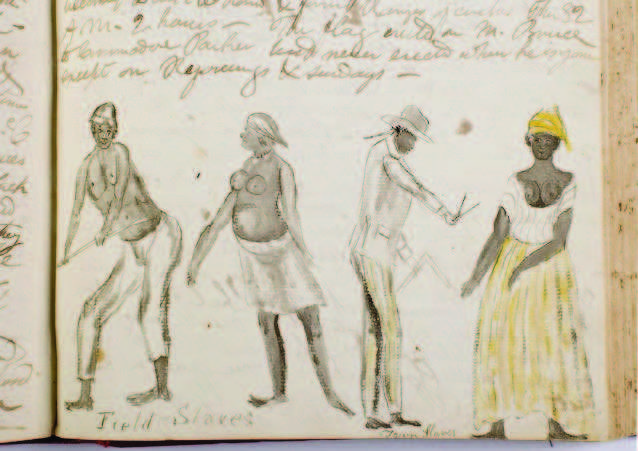African-Scottish families

Few Scottish women went to the Caribbean. Their husbands had relationships instead with women of West African origin or descent. Thousands of children were born from these interracial relationships.

Africans and people of African-European descent join in a dance at Dominica, by Agostino Brunias, 1779. (Courtesy of the John Carter Brown Library)
The men almost never married their African partners, although sometimes a man would buy the freedom of his enslaved lover. If he did not, he would have no rights over his children. By law, a child born to an enslaved woman belonged to the woman’s owner, regardless of who the father was.
Often it was the custom for the children to use their father’s surname. If they were born free and had a fairly light skin colour, their fathers often sent them to Scotland for education.
"Both Dr Fillan and Dr Clark have 6 children from mulatto [mixed race] girls who are called always after the man who takes them in keeping."
Jonathan Troup describes large African-Scottish families in Dominica, 1789

A portrait of an African-European woman from Dominica, by Jonathan Troup, 1789. (© The University of Aberdeen)
John Shand, of The Burn near Fettercairn, did this with the seven children he had in Jamaica with Frances Brown, a formerly enslaved woman of African and European descent. Most of the Shand children settled in Britain, including the youngest daughter, Frances Batty Shand. She became a charity worker and in 1865 founded the Cardiff Institute for the Blind.
But many African-Scottish children were simply abandoned by their fathers. On 26 March 1791 Jonathan Troup, the Aberdeen doctor in Dominica, wrote in his diary that his African lover Nancy was pregnant with his child. ‘I had to close with her,’ he noted, and sailed for Europe that very day.
"I mention with great regret that Dr O’Brien has married the mulatto [mixed race] woman with whom he cohabited – to ease his conscience he says. It is a degrading step – such conduct must damn a man in any community. Infatuated fellow!"
Hinton Spalding regrets his friend’s interracial marriage in Jamaica, 1830
Naming of enslaved people
Naming practices for enslaved people varied, but it was common for slavers to give newly arrived West Africans a European personal name like Betsy or Sam.
Sometimes these given names mocked the enslaved people’s lack of power by being deliberately grand, such as Caesar or King George. The enslaved people, however, often continued to use their African names among themselves and also passed them on to their children. Some of these names can provide clues to a family’s place of origin in Africa. For instance, ‘Cuffee’ is a variant of the name ‘Kofi’. This name comes from the Akan-speaking region of Ghana and is given to a male child born on a Friday.
Enslaved children who had European fathers often took their father’s surname. But they were sometimes named after their owner, rather than their father, especially if they were hired out to work for other people. In both cases, a lot of enslaved people ended up with Scottish surnames. Surnames from the North East that appear frequently in the Jamaican phonebook today include: Burnett, Dyce, Forbes, Gordon, Grant, Lamont, Leslie and Shand.
Colour consciousness in the Caribbean
Britain’s slaving colonies in the Caribbean were extremely conscious of racial difference.
They defined people by the colour of their skin and their biological heritage. These differences were enshrined in law and affected people’s legal rights.
Europeans controlled the political processes and had the most economic and social power. Below them on the power ladder were ‘free people of colour’. These were people of joint African and European ancestry who either had been born free or had been manumitted (freed) from slavery. After them came a very small population of ‘free Blacks’ or ‘free Negroes’ – Africans who had also been freed from slavery. Finally there came the enslaved people themselves – the majority of the population.
Even among enslaved people, however, a racial hierarchy prevailed. Those of mixed African-European descent had a higher status than African people. They were most likely to be employed as domestic servants and skilled workers, while the Africans were more likely to be forced to labour in the fields.
The range of distinctions meant that it was never a simple case of ‘white people’ versus ‘black people’. Many of the ‘free coloureds’, people of joint African and European ancestry, identified with the European minority rather than the African majority, because the Europeans had more power.
Societies involved in slavery used a precise terminology to define these racial differences. For example, the term ‘Mulatto’ meant a child born to a European and an African. The term ‘Sambo’ meant a child born to an African and a Mulatto, while ‘Mustee’ indicated a child born to a European and a Mulatto. These terms are offensive today and are no longer used, except by historians who try to understand how slave societies worked, and why Europeans viewed dark-skinned peoples as inferior to themselves.
John Shand and Frances Brown
John Shand (c.1759–1826) was the son of a North East wine merchant.
He sailed for Jamaica in the early 1780s, having failed in his first business venture in Scotland. There he became a successful manager of other people’s estates and eventually bought four properties of his own. In about 1800 he began a relationship with Frances Brown, with whom he was to have seven children. Frances was a woman of African and European ancestry who was apparently formerly enslaved on Belmont Estate, one of Shand’s properties. According to the lists of enslaved people for Belmont, members of her extended family remained enslaved on the plantation.
As a free woman and the partner of a wealthy man, Frances Brown had a relatively comfortable life in Jamaica. She received a permanent allowance from John Shand and had several enslaved people working for her at her house in Spanish Town. But she paid a high price for her relationship. John Shand left her in 1816 to retire to Scotland and all her children were taken from her at an early age to be raised in Scotland. She had a portrait of each one made when they left her, and, on writing her will in 1834, asked that each child be given their portrait as a memento of her.
Back in Scotland, John Shand invested his profits in The Burn and Arnhall Estate near Fettercairn. He expected to die a wealthy man and in 1821 he made a will leaving £5000 to each of his children. But his Jamaican properties were mismanaged and he lost much of his fortune, which means that his children may not have inherited as much as he intended for them. His Scottish estate was inherited by his brother William Shand who was also a plantation owner and slaver in Jamaica.
Frances Batty Shand
Frances Batty Shand, the youngest child of John Shand and Frances Brown, was born in Jamaica in about 1815.
Her father had her sent to Scotland in 1819, probably to the care of his unmarried sister, Helen. Helen ran a college in Elgin and had already taken responsibility for raising Millie, Frances’ older sister.
In 1826 Millie married a surgeon of Brechin, John Sandieman. Frances, who did not marry, lived for many years in Cardiff with her brother John, who became secretary of the Rhymney Railway Company. In Cardiff she threw herself into charity work, initially helping street children. In 1865 she opened a small workshop to provide employment for blind men making baskets for carrying coal to steam ships. The workshop grew rapidly and had twice moved to larger premises before she retired in 1877. Now called the Cardiff Institute for the Blind, the charity is housed in a building called Shand House in memory of its founder.
Frances died in Switzerland in 1885, but her body was brought back to Cardiff for burial in Allensbank Cemetery.
Jonathan Troup
Jonathan Troup was the son of Matthew Troup of Aberdeen.
He graduated in medicine from Marischal College in 1786 and sailed for Roseau in Dominica at the end of 1788. Dr James Clark, also of Aberdeen, had been working in Dominica for many years and he had recommended Troup as an assistant for Andrew Fillan, another doctor from North East Scotland who had a big medical practice on the island.
Troup’s diary records many aspects of the lives of the Europeans and Africans in Dominica, including some harrowing accounts of newly arrived Africans who were driven mad by despair.
Troup himself was deeply unsettled by life in a slaving society and found it impossible to stick at his work. He was proud of his university education and longed to make his name in scientific circles by recording noteworthy meteorological events and collecting natural history curiosities. This preoccupation infuriated Dr Fillan and Troup soon fell out with him. In 1791 he returned to Aberdeen to set himself up as a independent surgeon. He died at Corrachree in 1800.





